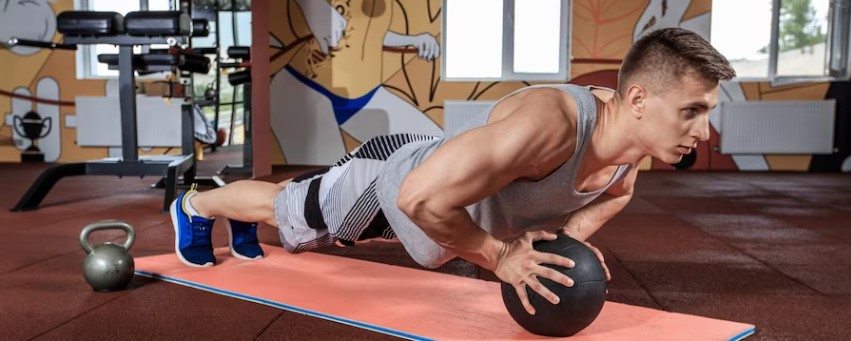Regular exercise is a key component of any weight loss journey, as it helps burn calories, increase metabolism, and build lean muscle mass.
In this article, we will discuss the importance of exercise for weight loss and provide an overview of the types of exercises that are most effective for achieving weight loss goals.
Whether you’re a beginner or an experienced exerciser, these tips and strategies can help you incorporate exercise into your weight loss plan and achieve your desired results.
I. Compound exercises for building muscle

Physical exercise is a crucial component of weight loss. In fact, it’s one of the most effective ways to burn calories, increase metabolism, and reduce body fat. While dieting can be effective in shedding some pounds, exercise helps preserve muscle mass, improves body composition, and provides numerous health benefits. In this article, we’ll discuss the many ways exercise can aid in weight loss and highlight the best types of exercise for achieving your weight loss goals.
A. How Exercise Helps with Weight Loss:
- Increases metabolism: Exercise increases metabolism and burns calories even after the workout. The body continues to burn calories to repair and recover from the stress of exercise. The more intense the workout, the more calories the body burns.
- Burns calories: Exercise burns calories, which is an essential component of weight loss. Burning more calories than you consume leads to a calorie deficit and weight loss.
- Preserves muscle mass: Resistance training such as weight lifting helps preserve muscle mass during weight loss, which is important for maintaining a healthy metabolism. When the body loses weight, it loses both fat and muscle mass. Resistance training helps to maintain muscle mass while shedding fat.
- Reduces body fat: Exercise reduces body fat, especially visceral fat, which is the dangerous fat that accumulates around the organs. Visceral fat is associated with numerous health problems, including heart disease, diabetes, and cancer.
B. Best Types of Exercise for Weight Loss:
- Cardiovascular exercise: Cardiovascular exercise, such as running, cycling, and swimming, is an excellent way to burn calories and improve heart health. Cardiovascular exercise raises the heart rate, which leads to an increase in calorie burn and improved cardiovascular health.
- Resistance training: Resistance training, such as weight lifting, is crucial for building and maintaining muscle mass. The more muscle mass a person has, the higher their metabolism, which leads to more calorie burn and greater weight loss.
- High-Intensity Interval Training (HIIT): HIIT involves short, intense bursts of exercise followed by periods of rest. This type of exercise increases metabolism and calorie burn, leading to more significant weight loss.
- Circuit training: Circuit training combines cardiovascular and resistance exercises for a full-body workout that burns calories and builds muscle.
Incorporating exercise into your weight loss plan is an excellent way to achieve your weight loss goals. Exercise increases metabolism, burns calories, preserves muscle mass, and reduces body fat. Cardiovascular exercise, resistance training, HIIT, and circuit training are some of the best types of exercise for weight loss. By incorporating these types of exercise into your routine, you’ll be well on your way to achieving your weight loss goals.
II. Isolation exercises for building muscle

Isolation exercises are a type of exercise that focus on a single muscle group, whereas compound exercises work on multiple muscle groups at the same time. These exercises are commonly used in bodybuilding and weightlifting programs to target specific muscles and enhance muscle growth. Here are some examples of isolation exercises for building muscle:
- Bicep curls: This exercise targets the bicep muscles in the upper arm. It is usually done with dumbbells or a barbell, and involves curling the weight up towards the shoulder while keeping the elbows still. Variations of the exercise include preacher curls and concentration curls, which involve using a bench or focusing on a single arm respectively.
- Tricep extensions: This exercise targets the tricep muscles in the back of the upper arm. It can be done with dumbbells, a barbell, or a cable machine. The exercise involves extending the arms above the head and then slowly lowering the weight behind the head. Variations of this exercise include overhead tricep extensions and tricep kickbacks.
- Leg curls: This exercise targets the hamstring muscles at the back of the thigh. It can be done with a leg curl machine or with resistance bands. The exercise involves bending the knees and curling the heels towards the buttocks. Variations include single leg curls and standing leg curls with a resistance band.
- Leg extensions: This exercise targets the quadriceps muscles at the front of the thigh. It can be done with a leg extension machine or with resistance bands. The exercise involves straightening the legs and lifting the weight with the feet. Variations of this exercise include single leg extensions and sissy squats.
- Lateral raises: This exercise targets the shoulder muscles. It can be done with dumbbells or a cable machine. The exercise involves raising the arms out to the side to shoulder height. Variations include front raises and rear delt flys.
Isolation exercises can be beneficial for targeting specific muscles and enhancing muscle growth. However, it’s important to incorporate compound exercises into your workout routine as well, as they work on multiple muscle groups and can help increase overall strength and fitness. It’s also important to use proper form and technique, and to gradually increase the weight and resistance over time for progressive overload.
As with any exercise program, it’s crucial to consult with a healthcare professional before starting a new workout routine, especially if you have any underlying health conditions or injuries. By incorporating isolation exercises and compound exercises into your workout routine, you can build muscle and achieve your fitness goals.
III. Body weight exercises for building muscle

Body weight exercises are a convenient and effective way to build muscle, as they require no equipment and can be done anywhere. Here are some of the top body weight exercises for building muscle:
- Push-ups: Push-ups are a classic exercise that work the chest, shoulders, triceps, and core. To do a push-up, start in a plank position with your hands shoulder-width apart. Lower your body down to the ground, keeping your elbows close to your body, and then push back up.
- Pull-ups: Pull-ups are a challenging exercise that work the back, biceps, and shoulders. To do a pull-up, find a sturdy bar or other object you can grip with your hands. Hang from the bar with your palms facing away from you and pull yourself up until your chin is above the bar. Lower yourself back down and repeat.
- Dips: Dips are a great exercise for working the triceps, chest, and shoulders. To do a dip, find parallel bars or two sturdy objects that you can grip with your hands. Lower your body down until your elbows are bent at a 90-degree angle, and then push yourself back up.
- Squats: Squats are a compound exercise that work the legs, glutes, and core. To do a squat, stand with your feet shoulder-width apart and lower your body down as if you were sitting in a chair. Keep your weight in your heels and your knees behind your toes. Push back up to the starting position.
- Lunges: Lunges are another great exercise for building leg muscle. To do a lunge, take a big step forward with one foot and lower your body down until your front knee is bent at a 90-degree angle. Push back up to the starting position and repeat on the other side.
IV. Tips for maximizing muscle growth through exercise

To maximize muscle growth through exercise, there are a few key tips to keep in mind:
- Progressive Overload: Progressive overload is the gradual increase of stress placed on the body during exercise. To build muscle, it’s important to continually challenge your muscles by progressively increasing the weight, reps, or sets of an exercise. This forces the muscle to adapt and grow over time.
- Proper Form and Technique: Performing exercises with proper form and technique is essential for maximizing muscle growth and preventing injury. This includes maintaining good posture, engaging the correct muscles, and using a full range of motion.
- Recovery and Rest: Recovery and rest are crucial for muscle growth. Adequate rest allows the body to repair and rebuild muscle tissue that has been broken down during exercise. This includes getting enough sleep, taking rest days, and giving your muscles time to recover before working them again.
- Proper Nutrition: Proper nutrition is essential for muscle growth. This includes consuming enough protein, which is necessary for muscle repair and growth, as well as sufficient calories to fuel your workouts. Additionally, staying hydrated and consuming a well-rounded diet with adequate vitamins and minerals can support muscle growth.
- Variety and Progression: To maximize muscle growth, it’s important to incorporate a variety of exercises and to gradually increase the intensity and complexity of your workouts over time. This helps prevent plateaus and keeps your muscles challenged.
By incorporating these tips into your workout routine, you can help maximize muscle growth and achieve your fitness goals. However, it’s important to listen to your body and speak with a healthcare professional before starting any new exercise program, especially if you have any underlying medical conditions or injuries.
Conclusion
In conclusion, there are a variety of exercises that can be effective for building muscle, including compound exercises like squats and deadlifts, isolation exercises like bicep curls and leg extensions, and body weight exercises like push-ups and pull-ups.
To maximize muscle growth, it’s important to focus on progressive overload, proper form and technique, and adequate recovery and rest. By incorporating these exercises and principles into a consistent workout routine, individuals can achieve their muscle-building goals and improve their overall health and fitness.
It’s important to remember to consult with a healthcare provider or certified fitness professional before starting a new exercise program, especially if you have any underlying health conditions or are new to exercise.



